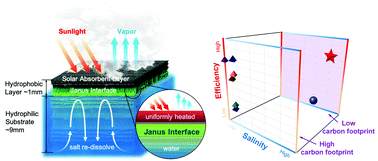Sustainable off-grid desalination of hypersaline waters using Janus wood evaporators†
Abstract
Solar-thermal evaporation is a promising technology for energy-efficient desalination, but salt accumulation on solar absorbers and system longevity are the major challenges that hinder its widespread application. In this study, we present a sustainable Janus wood evaporator that overcomes these challenges and achieves a record-high evaporation efficiencies in hypersaline water, one of the most difficult water sources to treat via desalination. The Janus wood evaporator has asymmetric surface wettability, where the top layer acts as a hydrophobic solar absorber with water blockage and salt resistance, while the bottom hydrophilic wood layer allows for rapid water replenishment and superior thermal insulation. An evaporation efficiency of 82.0% is achieved for 20% NaCl solution under 1 sun, and persistent salt-resistance is observed during a 10-cycle long-term test. To ensure the environmental impact of the Janus wood evaporator, for the first time, a life cycle assessment (LCA) is conducted to compare this Janus wood evaporator with the emerging Janus evaporators, indicating a functional and more sustainable opportunity for off-grid desalination and humanitarian efforts.

- This article is part of the themed collection: Energy & Environmental Science Recent HOT Articles


 Please wait while we load your content...
Please wait while we load your content...
